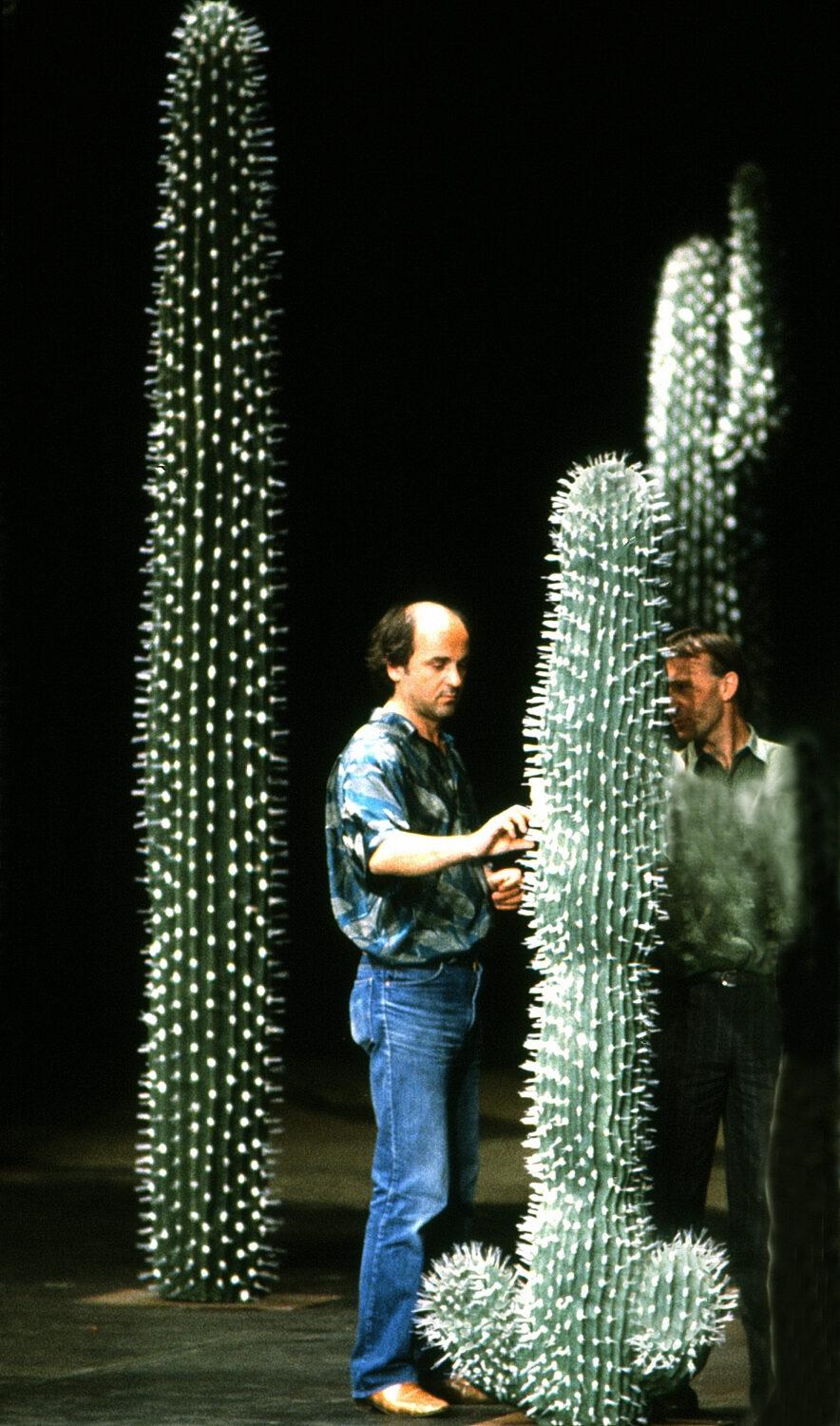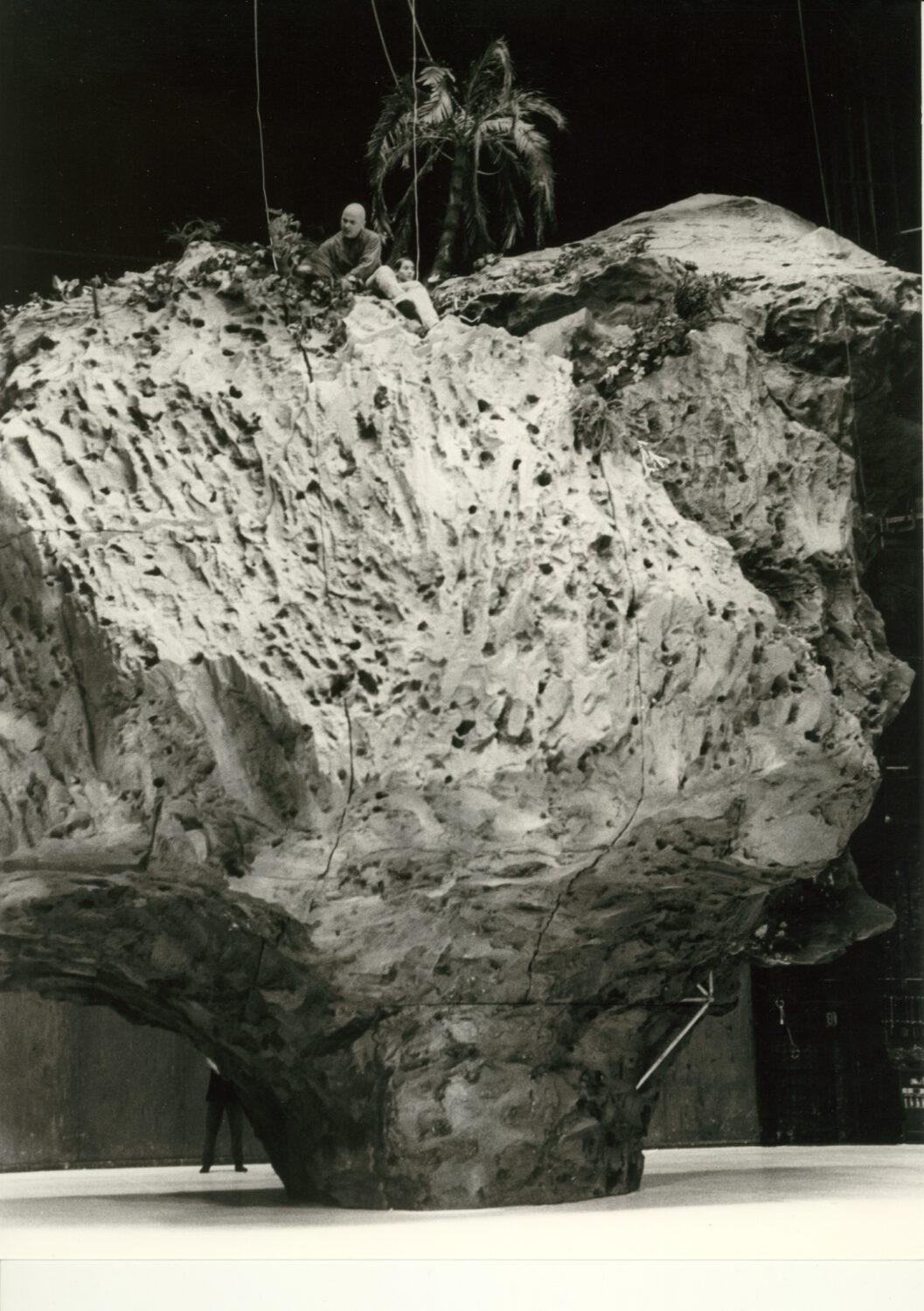Peter Pabst - Biography
In Peter Pabst‘s office in Wuppertal
Peter Pabst
was born in 1944 in Grätz (Grodzisk Wielkopolski) in Poland and grew up in East Berlin. In 1954 his family moved to Frankfurt am Main where he was to drop out of school and start an apprenticeship as a dressmaker. The choice of profession was far from random as his mother had run a fashion business in Berlin, where her commissions included costumes for the city's theatres. She got her son a job with Elise Topell in Wiesbaden, one of the most sought after haute couture designers in post-war Germany. Accompanying Topell, Pabst attended the big fashion shows in Paris, where he was introduced to the leading lights of the discipline.
Theatre and Film
His ambitions shifted, however. He was given the opportunity to work with the director of costume at Bayreuth, Kurt Palm, and costume design became his new interest. Palm was a true master with an enormous sense of quality. A new world was opened up to Pabst in which, alongside technical skill, another kind of creativity was required. In 1969 he applied to Cologne’s art college to study costume and set design and was accepted. This was the period when students ruled the roost and Pabst involved himself in the running of his course. This included finding a new head of stage design and he succeeded in attracting Max Bignens from Switzerland. Pabst describes Bignens as an 'absolute authority' and 'a wonderful teacher'. Yet once more he failed to complete the course and moved straight to the workplace. Bignens suggested he introduce himself to the director of the Bochum theatre, Peter Zadek. Their meeting formed the beginning of a life-long friendship and working relationship; from 1973 to 1979 Pabst was employed full time at Bochum. He designed the costumes for Zadek's Professor Unrat and Hedda Gabler as well as productions of Othello, Spring Awakening and Hamlet. During this time, more by chance, he also began collaborating with the Argentinian guest director August Fernandes. The house set designer Götz Löpelmann had a problem with Fernandes and Pabst intervened to mediate. Thus he designed the costumes for Doña Rosita the Spinster and both sets and costumes for The House of Bernarda Alba. Although as a fledgling set and costume designer he had the feeling he was making every possible mistake, his work was positively received. He was interested in many different areas and became one of the first set designers to work throughout the genres; it was still more typical at the time for a designer to focus their career in just one of the performing arts. Pabst created costumes and sets for theatre, opera and film and in the process worked with some of the finest directors of the time, including Hans Neuenfells, Luc Bondy, Kalle Homberg, Andrej Serban, Peter Eschberg, Tankred Dorst, Peter Löscher, Jerôme Savary, Klaus Maria Brandauer, Robert Carsen, Chen Shi-Zheng, Johannes Schaaf, Emir Kusturica, Istwan Szabo and Wim Wenders. The film work in particular taught him a lot about discipline.
Dance
The addition of a further genre, dance, seemed at first simply an optional extra. Pabst had already met Pina Bausch and her set and costume designer Rolf Borzik - also her partner – in Bochum in 1978 while Bausch was rehearsing her Macbeth-based guest choreography Er nimmt sie an der Hand und führt sie in das Schloß, die andern folgen (He takes her by the hand and leads her into the castle, the others follow). They got to know each other in the canteen and became friends. Two years later Borzik died, and Pina Bausch asked Peter Pabst to take over the set design for 1980. He was unsure, but felt unable to say no to Bausch, who had just lost her significant other. His years with Peter Zadek proved to have prepared him well for the work with the Tanztheater Wuppertal for, like Pina Bausch, Zadek viewed a production as an adventure with an uncertain outcome. Pabst had learned to live with the uncertainty and to cope with not knowing everything. It was exactly these abilities which were continually tested at Wuppertal, because at the beginning of a rehearsal process there was nothing yet – at the most an idea, a subject. For a long time it remained unclear what kind of space each piece might settle in. Pabst created up to six different set designs for each piece. There were many, diverse requirements.
Physical Spaces
Dance theatre spaces are physical spaces. They need to be danceable in but often they also place material resistance in the dancers' way: earth, water, the stones of a fallen wall or a sea of carnations. They should be reduced to the minimum necessary, but at the same time create a certain poetry. In one area Bausch and Pabst definitely saw eye to eye: neither were fans of mere decoration. The space created for each piece should have an autonomous function and should ideally be able to change. One of Pina Bausch's standard reactions on being shown a set design was, 'and what else can it do?' The changes take very different forms; they can be dramatic, as in Palermo Palermo in which right at the start a high wall falls with a crash to leave a field of rubble and broken bricks. In Ein Trauerspiel (A Tragedy) an enormous waterfall pours down onto the stage, later a huge fountain of fire shoots up from the water, next to the large floating island at the centre of the stage. Pabst loved the technical challenges such ideas presented him with, and beavered away till an aesthetically satisfying solution was found. He meticulously checked the safety of the constructions and the materials used so that the dancers were not placed in any danger.
Change
The changes are sometimes imperceptible, as in Nefés. Here the stage floor is covered with dark wood which sinks to a gentle depression in the middle. Very slowly the hollow fills with water, which disappears as imperceptibly as it appeared. In Vollmond water flows down a channel although we are unaware of the current till a dancer floats by on an airbed and we realise what physical laws are at work here. It often rains in the pieces: everything from fine drizzle to thundering downpours. In the last piece, which has remained untitled, cracks open and close in the ground, controlled by an invisible hand; as if the earth is threatening to break apart under the dancers' feet. It is this complexity, this diversity of potential change, which lends the stage sets their sophistication and ensures that magical moments occur in the theatre.
Like Pina Bausch in her pieces, Peter Pabst avoids explicit statements. Only in this hinterland of hints and pointers is there space for the audience to fill the thematic outlines with their own imagination and interpret them in any of many ways. The spaces have to be sensual, because the sensuality changes the dancers' presence and the audience's perception. Thus is it no surprise that nature is often used – as material and as subject. Nature, the opposite of the artificial space of the theatre, becomes something uniquely disturbing and beautifully displaced. Outside of the theatre a meadow of carnations is nothing more than a meadow of carnations. On the stage of an opera house, even if these are artificial carnations, it becomes a space where dreams can unfold. When, at the end of the show, the flowers have been trampled flat, they hold the traces of what has happened on stage. This is another recurring motif, along with the changes the space makes to the performers, their clothes becoming wet and revealing their bodies, their actions forced to accommodate the hindrances of water, earth and stone. The materiality of these spaces is what makes them tangible and experienceable to the audience. This lends a whole new authenticity to the actions. What we see – their exhaustion from the encounter with the materials, as well as the risk – is real, not stated.
A perfect collaboration
Peter Pabst has the necessary feeling for creating spaces which work on this level, far exceeding the normal requirements of scenography, and he has the patience needed to find consensual solutions. Patience and art are intrinsically linked for him; patience, in order to wait till the essential idea has been arrived at together, but also patience with himself, not to demand things which are not (yet) possible. This patience is also demanded by dance theatre pieces and their spaces. They only take effect when we become involved with them, take the time to experience them, to persevere through the annoyances, ride the ups and downs and at the end – perhaps – emerge just as exhausted and happy as the dancers themselves.
Peter Pabst designed and produced theatrical spaces for the Tanztheater Wuppertal for over twenty-five years. It was one of the most unusual and longest-running collaborations ever seen in the performing arts. When asked what had held him in there, despite recurring 'hellish lows' of uncertainty, he emphasized above all both sides' continual ability to surprise each other and cope together with their respective vulnerabilities without burdening the other with their difficulties. This could also be described as an attitude of deep respect, a respect which the Tanztheater Wuppertal's pieces also reinstate – for every human being.
In 1991 Peter Pabst was awarded the Josef Kainz Medal of the city of Vienna and since 1992 has held the title Chevalier des Arts et de Lettre. In 2010 he was awarded the title ‘Professor’ by the minister-president of the state of North Rhine-Westphalia and in 2014 honoured with the prestigious Von Der Heydt Kulturpreis from the city of Wuppertal.
In 2010 PETER FOR PINA was published, a lavishly illustrated book covering his twenty-nine years working for Pina Bausch and the Tanztheater Wuppertal. He has also created four exhibitions: Räume-Träume (‘spaces – dreams’) at Kunstmuseum Bochum, 2008; Caution as a Precaution at Tony Cragg’s Waldfrieden Sculpture Park, 2014; So schön wie möglich (‘as beautiful as possible’) in the Wuppertal theatre workshops, 2014; and WHITE RED PINK GREEN in Seoul, Korea, 2019.
Text by Norbert Servos
Translated by Steph Morris



